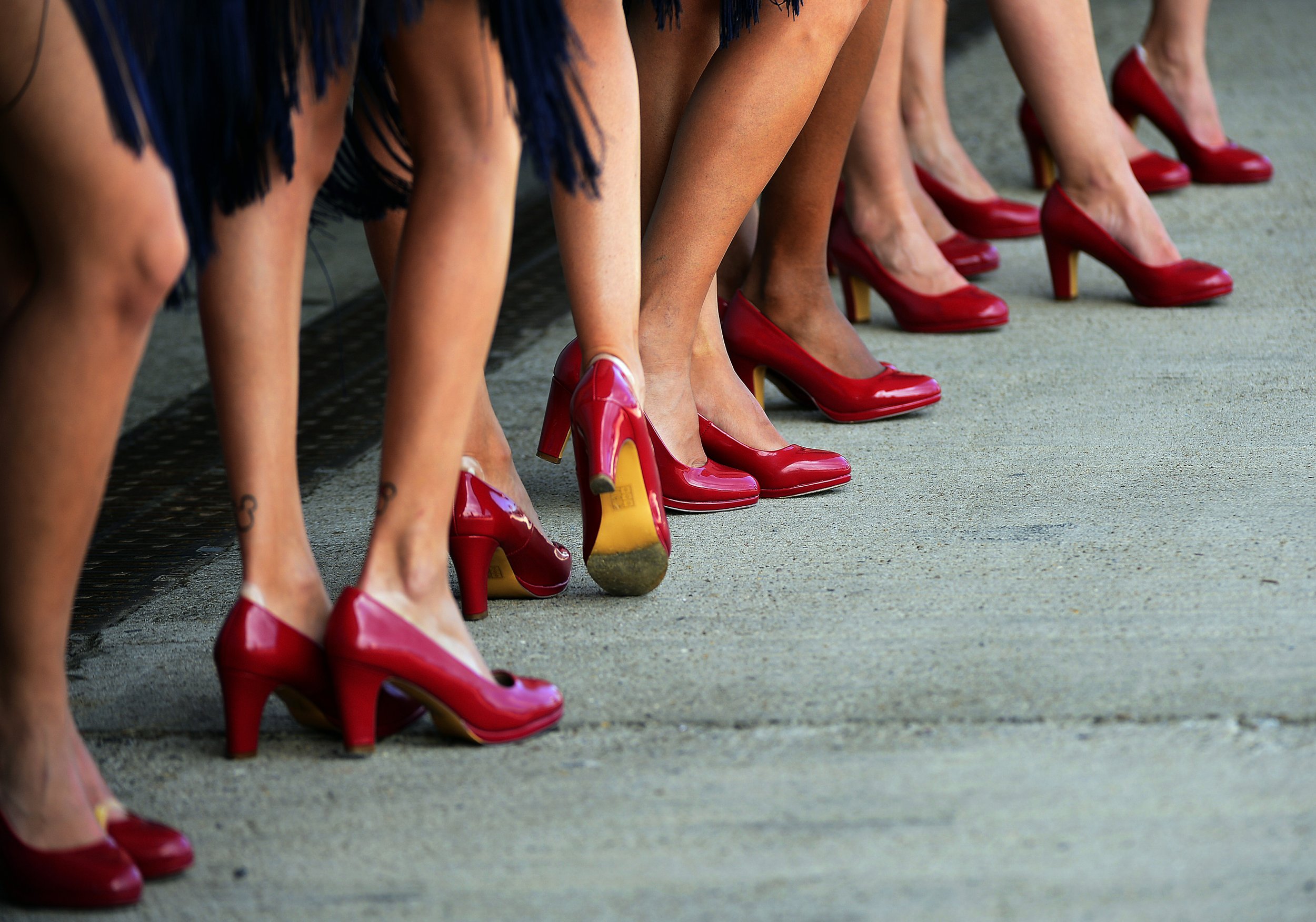
Ever noticed that when you type the word shoe in your smartphone, the only traditionally "female" emojis are high heels? You can choose between a red stiletto, a white mule and a tan boot.
Florie Hutchinson made this discovery last spring, while nursing her 6-month-old daughter. She was texting her sister-in-law, and when she typed shoe, the default emoji was the stiletto. Hutchinson, an independent arts publicist in Palo Alto and a mother of three daughters, thought, This is absurd! Who decided that the female shoe must have a heel? I wanted to throw my phone against the wall."
This was the last straw on the sort of day that reminds women of how overtly sexist and gendered mass culture remains. First, one of Hutchinson's daughters picked up a book at a local supermarket titled Polite as a Princess, with Snow White, Sleeping Beauty and Cinderella smiling like good little Stepford beauties on the cover. Her next stop was a children's store—she needed a new baby carrier. "While the girls are looking at overpriced $100 bamboo cotton onesies, I realize that out of the 30 boxes of baby carriers, all but one has a picture of the mother carrying the baby. I'm like, where are the men?"

She calls the red stiletto her "sleep-deprived aha moment," and a month later she submitted a proposal for a ballet flat to the Unicode Consortium, the nonprofit that oversees and standardizes emoji across platforms. A dozen elite companies (mostly U.S. tech giants, including Apple, Google and Facebook) pay $18,000 a year for the right to vote on new emojis, and if Hutchinson's flat is approved at the group's meeting this week, it could appear on billions of devices next year. "When Melania Trump and Stilettogate happened, I was like, where is my flat emoji when I need one?!" she says, referring to the fuss made over the first lady wearing stilettos to visit hurricane-ravaged Houston.
Hutchinson isn't alone. Last week, Katrina Lake, founder and CEO of the online clothing company Stitch Fix, pointed out that when she typed the word CEO into her iPhone, she got an emoji of a man in shirt and tie. "Hi! I actually look more like this," she tweeted, along with an emoji of a woman in a purple shirt.
If you're rolling your eyes, thinking emojis are nothing more than a playful visual shorthand for poop and sex, think again. They have inspired everything from Halloween costumes to Hillary Clinton's presidential campaign to President George W. Bush's interactions with his daughters. The Leslie Mann comedy, Blockers, due April 2018, is premised on an emoji-only text conversation between three teenage girls on prom night. Makes sense when you consider that 90 percent of the world's online population use emoji—on Facebook Messenger alone, and 5 billion emoji are sent every day.
Consider that we live in a world where children are given smartphones and tablets as pacifiers—where they learn how "to emoji" before they can read and write. Today, 98 percent of children age 8 and under live in a home with a mobile device, according to a new report from Common Sense Media. And the average amount of time kids spend on those devices has skyrocketed from five to 48 minutes a day over the last six years. This is why emojis matter.
"There's this false perception that things served up to us by machines are unbiased," says Jane Solomon, a lexicographer at Dictionary.com who sits on the Unicode Emoji Subcommittee, which considers proposals. "You have to ask, 'Who programmed that machine? Who made the decision that brought you a stiletto heel as the representation for a woman's shoe?'… I think a lot of people write off emojis as being superficial, but it's a very real way people communicate."
These days, there is heightened focus on ensuring that gender, race and sexual orientation are represented in Hollywood, awards shows, corporate boards, magazine covers—pretty much everywhere. And it's fair to expect further progress in a post–Harvey Weinstein world. But what's at stake if we don't fully democratize emoji, fast becoming the first language of children?
The Birth of Emojis
In 1999, a young Japanese engineer at a phone company created a set of 176 simplistic images—smiley faces, musical notes, trains—to appeal to teenagers. It wasn't until 2011 that Apple brought them to America. This first generation was rife with blind spots, especially around gender and diversity, but that's because "they were descended from the Japanese emoji, which were never meant to be universal," says Jennifer 8. Lee, a former New York Times journalist and co-founder of Emojination, an organization dedicated to making emoji more inclusive (tagline: Emoji by the people, for the people).

Until recently, the official emoji keyboard offered women four career tracks: bride, princess, flamenco dancer and Playboy Bunny. The only skin color was yellow, which of course read as white, and there was no such thing as an interracial couple or family. These glaring missteps are slowly being corrected. Starting in 2015, Unicode introduced racially diverse emojis, female kissing female, male kissing male, and LGBT couples (both with and without kids). Last year, Unicode approved 11 new professions for men and women (including judge, pilot, teacher and artist), and made existing emojis both male and female (yes, that's two guys dressed as Playboy Bunnies). A Muslim teenager in Germany successfully petitioned Unicode to add a hijab-wearing woman emoji.
Of the last 67 emojis Unicode approved, Emojination helped pass at least 40, including the hijab, llama, lobster and bagel. But not everything merits attention, at least according to Emojination. "We keep getting proposals around menstruation, like bloody underwear, that just aren't going to pass! And there is trouble with the condom emoji," says Lee. "Here's the thing: It's a global visual language, which means you have all the cultural constraints. For example, it's not technically a wine or beer emoji, because some Muslim countries didn't like that. It's a wine glass and beer mug. That's OK."
Pleasing everyone is impossible. This summer, Facebook unveiled 125 diverse family emojis, including light, medium and dark skin tones, only it was impossible to create interracial families. "And when they introduced female professions," says Lee, "you ended up with male and female versions of everything—police officer, medic—and that made all the non-gender-binary people agitated, because they felt they were being forced into gender binary." Earlier this year, Unicode approved the first gender-neutral emojis, with child, adult and older person.
The official emoji keyboard is still rife with familiar and frustrating stereotypes. Punch in dress and you get a low-cut turquoise number with a tiny waist. Bathing suit brings up a pink polkadot bikini. More than simple ciphers, these simplistic symbols have come to express something much more complex, a way to reveal who we are and how we want to be viewed. Sometimes a shoe is just a shoe, and sometimes it's an affront—or a revolution.
"If I can make sure at least one word has options for my daughters, of course I'm going to do it," says Hutchinson. "Children consume digital books and language, and they're literate in it, so why smack them with a sexualized stereotype like a stiletto from early childhood?"
By age 5 or 6, children can understand up to 14,000 words, says Eve Clark, a linguistics professor at Stanford University. But when I asked a handful of psychologists and child development experts what's at stake for kids who learn how "to emoji" before they can read and write, most replied with some version of, Great question!
There's a reason for that: Technology changes so quickly that academic researchers—who often spend years getting from concept to publication—simply can't keep up. "It's like saying, 'Is there any complete research on the effects of Pokémon Go?'" says Michael Rich, director of the Center on Media and Child Health at Boston Children's Hospital. "We do know that looking at a woman as a Playboy Bunny, and not much else, has an effect on children long-term, whether as an emoji or in Playboy magazine. We can extrapolate from research we do have about the formation of gender and stereotypes and apply it to emoji, and feel reasonably sure that this is a valid concern."
If anything, it's a representation, says David Anderson, senior director of the ADHD and Behavior Disorders Center at the Child Mind Institute, "of just how vigilant we have to be to each new form of communication for kids."
Uncommon Knowledge
Newsweek is committed to challenging conventional wisdom and finding connections in the search for common ground.
Newsweek is committed to challenging conventional wisdom and finding connections in the search for common ground.
About the writer
Abigail Jones is an award-winning journalist and New York Times bestselling author. Her Newsweek cover story, “Life After Eleven Years ... Read more
To read how Newsweek uses AI as a newsroom tool, Click here.






